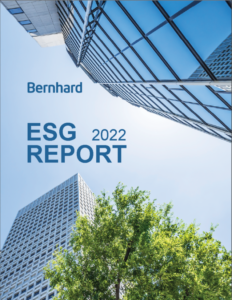________________
Leighton Wolffe is a technology trailblazer. He helped create many of the ideas that define demand management and has been a thought leader in the energy industry for more than 30 years, serving as a consultant to Harvard University, Marriott Corporation, Cedars-Sinai Medical Center, Constellation Energy and others. After decades helping develop and deploy software applications and innovative energy technologies, Wolffe recently made the decision to depart from Northbridge Energy Partners, LLC, a consulting firm he co-founded, and join Bernhard as Vice President of Demand Management.
Through Bernhard’s work in building controls, integrating remote operations centers and forming decades-long Energy-as-a-Service (EaaS) agreements with large-campus hospitals and universities, Wolffe has found the perfect partner. Wolffe marries his deep industry experience and energy market knowledge with Bernhard’s rich engineering and facilities management legacy to elevate customer buildings with distributed energy systems and the technologies necessary to interoperate with energy markets
A visionary leader in demand response
Wolffe parlayed his ability to understand energy use on large campuses into high-profile jobs, as Energy consultant at Harvard Medical School, and as Project Manager for Cedars-Sinai Medical Center in Los Angeles, with more than 3 million square feet of healthcare space. Eventually, Wolffe made his way to Marriott Corporation, where he consulted and then joined as Director of Engineering & Facilities.
It was during his time at Marriott that he became interested in the emerging field of automated building control systems. “I was fascinated with the technology,” Wolffe said. “But why it was so expensive, why it didn’t consistently work, and how could it be better used to meet the challenges we faced managing our operations in the context of energy and environmental conditions?”
By the early 2000s, Wolffe was pushing the envelope of smart buildings, including utilizing next-generation technologies like artificial intelligence, predictive automation and neural networks to control buildings.
“This was the same technology used by stock market traders for micro trading and for weather forecasting,” he said. “We were using neural networks to predict conditions based on vast amounts of historical data sets. I consulted for companies like that, and then because energy was such a large part of my focus, I wanted to deliver the solutions that I knew worked.”
After forming a systems integration company and directly implementing these systems in commercial and mission critical buildings, Wolffe came to what he called the most interesting part of his career, working with Constellation and Peter Kelly-Detwiler, who would later go on to cofound Northbridge Energy Partners with him. Constellation, which provided energy for two-thirds of the corporations in the Fortune 100, wanted to be able to create call options for the buildings they served and integrate supply contracts with demand management services.
During his tenure with Constellation, Wolffe helped co-develop and patent Virtuwatt, a portfolio energy management platform that connected customer buildings with energy markets. Virtuwatt enabled them to unlock the true promise of demand response by shaping, shifting and shedding load based on market conditions, pricing signals and demand response events.
At Constellation, Wolffe and his team set up the NewEnergy Alliance that introduced the building automation industry to the emerging demand response programs being formed in each energy market. Since these building systems were already resident in many commercial and industrial facilities, it made sense to leverage them wherever possible. In order to bring the concept full circle, buildings needed to be connected to so they could respond to signals from the grid.
“The Virtuwatt platform did that,” he said. “It provided all the elements necessary to enable customer participation in the North American deregulated energy markets. We took it further for our customers who we were serving with electricity. The goal was to create capabilities in each site that could dynamically shape demand through advanced control strategies to align buildings with market conditions – and simultaneously provide options for positive cash flow by nominating unused load back into the grid – creating virtual power plants. In addition to large campuses, since many of our customers were national accounts with large portfolios, we had to develop the platform to operate at the enterprise level across every market.”
Wolffe’s extensive background will empower Bernhard to manage energy use and improve supply contracts for new and existing clients, leverage and aggregate DER resources, and negotiate better supply contracts on behalf of clients. Wolffe’s knowledge of building technologies and competitive energy markets make him a valuable addition to Bernhard’s executive leadership.
The future of demand response and energy markets
Regulatory, legislative and energy policy activities in the United States are in constant movement and evolving at state, Federal and regional levels. These changes impact the suppliers and the consumers and drive investment in renewable energy technologies. In order for consumers to successfully plan and implement long-term energy strategies, they need to know about these changes and plan for the inflection point when rulings take place. Moreover, customers need to work with partners and vendors who know how to deliver products & services that keep customers ahead of the energy curve in current and future state markets.
Announced in September 2020, the Federal Energy Regulatory Commission (FERC) Order 2222 requires independent system operators (ISO) and regional transmission organizations (RTO) in the U.S. to develop plans that give Distributed Energy Resources (DER’s) access to wholesale energy markets. This reimagining of the U.S. electricity grid is predicted to flood markets with firm and intermittent energy resources, impacting how power supply contracts are negotiated and how customers pay for energy.
The order promotes competition in electric markets and levels the playing field for organized capacity, energy and ancillary services. In addition, the Inflation Reduction Act (IRA) will provide incentives and tax credits for many of the DER’s offered by Bernhard. By ushering in micro-grids that exist behind the meter, customers are primed to place their facilities on the cutting-edge of a futuristic electric grid. Wolffe and Bernhard will take the company’s expertise in engineering and building systems and capitalize on FERC Order 2222 for new and existing clients.
Bernhard provides flexible Energy-as-a-Service agreements to customers, some ranging from 10 to 20 and even 30 year intervals. These agreements place teams on the ground in for facilities to preserve the trust and investment placed in Bernhard by upgrading existing systems with new equipment and energy management systems.
For the markets that Bernhard serves, chiefly healthcare and higher education, it’s not common for facility operations to understand the complexities and intricacies of energy markets, and develop the capabilities to participate effectively. As a result, many institutions have been unable to leverage themselves to the benchmark of energy markets and justify the capital expense to upgrade their systems. Bernhard teams are prepared to do the heavy lifting for the customer and bring their facilities up to speed. Now, with a clear focus on energy markets, Bernhard is sitting in a prime position to further reduce energy usage, costs and constraints on facilities, by assisting them in interoperating with the energy markets through distributed energy resources and improved operating systems.
As a consultant, Wolffe was often frustrated when market opportunities weren’t acted upon. “I’m a doer.” He said. “My focus is creating successful outcomes.” His new position at Bernhard allows him to be a facilitator for the customer at a larger scale than ever before. By enabling customers to take advantage of Distributed Energy Resources, Bernhard is creating pricing stability in regulated and deregulated markets, allowing the customer to mitigate risk, avoid volatile pricing and work toward decarbonization and a more sustainable future.
Prepare your business for the energy grid of tomorrow and join us in our mission for sustainability. In turn, you’ll reduce energy use, cost, risk and retain focus on your mission. There’s never been a better time to get started and with demand response. Contact the experts at Bernhard today.

